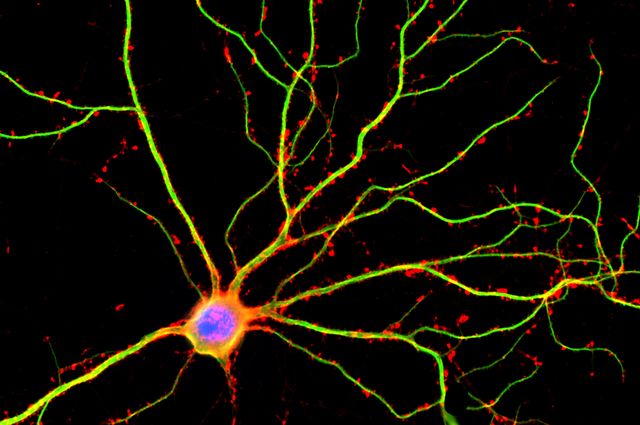Brain is 10 times more active than previously measured
by noreply@blogger.com (brian wang) from NextBigFuture.com on (#2FJVV)
A new UCLA study could change scientists' understanding of how the brain works - and could lead to new approaches for treating neurological disorders and for developing computers that "think" more like humans.
The research focused on the structure and function of dendrites, which are components of neurons, the nerve cells in the brain. Neurons are large, tree-like structures made up of a body, the soma, with numerous branches called dendrites extending outward. Somas generate brief electrical pulses called "spikes" in order to connect and communicate with each other. Scientists had generally believed that the somatic spikes activate the dendrites, which passively send currents to other neurons' somas, but this had never been directly tested before. This process is the basis for how memories are formed and stored.
Scientists have believed that this was dendrites' primary role.
But the UCLA team discovered that dendrites are not just passive conduits. Their research showed that dendrites are electrically active in animals that are moving around freely, generating nearly 10 times more spikes than somas. The finding challenges the long-held belief that spikes in the soma are the primary way in which perception, learning and memory formation occur.
"Dendrites make up more than 90 percent of neural tissue," said UCLA neurophysicist Mayank Mehta, the study's senior author. "Knowing they are much more active than the soma fundamentally changes the nature of our understanding of how the brain computes information. It may pave the way for understanding and treating neurological disorders, and for developing brain-like computers."

Shelley Halpain/UC San Diego
UCLA scientists discovered that dendrites (shown here in green) are not just passive conduits for electrical currents between neurons.
Science - Dynamics of cortical dendritic membrane potential and spikes in freely behaving rats
Read more










The research focused on the structure and function of dendrites, which are components of neurons, the nerve cells in the brain. Neurons are large, tree-like structures made up of a body, the soma, with numerous branches called dendrites extending outward. Somas generate brief electrical pulses called "spikes" in order to connect and communicate with each other. Scientists had generally believed that the somatic spikes activate the dendrites, which passively send currents to other neurons' somas, but this had never been directly tested before. This process is the basis for how memories are formed and stored.
Scientists have believed that this was dendrites' primary role.
But the UCLA team discovered that dendrites are not just passive conduits. Their research showed that dendrites are electrically active in animals that are moving around freely, generating nearly 10 times more spikes than somas. The finding challenges the long-held belief that spikes in the soma are the primary way in which perception, learning and memory formation occur.
"Dendrites make up more than 90 percent of neural tissue," said UCLA neurophysicist Mayank Mehta, the study's senior author. "Knowing they are much more active than the soma fundamentally changes the nature of our understanding of how the brain computes information. It may pave the way for understanding and treating neurological disorders, and for developing brain-like computers."

Shelley Halpain/UC San Diego
UCLA scientists discovered that dendrites (shown here in green) are not just passive conduits for electrical currents between neurons.
Science - Dynamics of cortical dendritic membrane potential and spikes in freely behaving rats
Read more